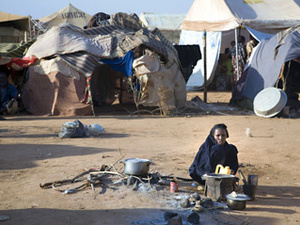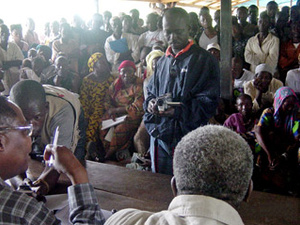Guinea: race against time to move refugees
Guinea: race against time to move refugees
In a race against time and the weather, UNHCR is stepping up its efforts to move tens of thousands of refugees away from volatile border zones in south-western Guinea to safer sites in the interior of the country.
These efforts include:
- The deployment - security permitting - of more UNHCR search teams into the isolated "Parrot's Beak" region to bring people to safety;
- The opening this week of a second new refugee settlement in the Albadaria region of central Guinea;
- And ongoing construction of two more new sites in the same area.
So far, more than 27,000 refugees have been relocated from the "Parrot's Beak" - a thumb of Guinean territory jutting into Sierra Leone - to the Albadaria area, north of the town Kissidougou. The Parrot's Beak has been largely cut off by fighting since last September, leaving thousands without regular humanitarian assistance. The impending onset of the rainy season also adds to the urgency of the relocation effort.
Relocating the Sierra Leonean refugees from dozens of settlements in the insecure south-west to safer parts of Guinea remains UNHCR's No. 1 priority. Many of the settlements in the Parrot's Beak are deserted or destroyed following recent fighting in the region, and tens of thousands of the refugees have now congregated in just a few camps. One of them, Kolomba, on the farthest tip of the Parrot's Beak, currently has some 60,000 people. Some are so desperate that they are taking the risk of walking back to Sierra Leone through dangerous, rebel-controlled borderlands.
Working closely with Guinean authorities and as security conditions allow, UNHCR transport teams are moving deeper into the Parrot's Beak region to bring refugees to safety in the north. Yesterday (Thursday), a UNHCR convoy of 30 trucks transferred some 1,000 refugees from the camp of Koundou Bengo Lengo to a temporary transfer site at Katkama, on the northern edge of the Parrot's Beak. The refugees are later transferred from Katkama, which currently has some 12,000 refugees, northwards to the Albadaria region where a new camp at Boreah opened this week. Boreah, which opened Wednesday, is the second new camp in the Albadaria area. The first was Kountaya, which has already reached its capacity of 26,000 people. Two others currently under construction, Télikoro and Mandoukoro, will bring the total capacity of the four camps in Albadaria to about 60,000 refugees. More sites are also planned in the Dabola region to the west. Refugee families at the new sites will be given materials to build their own houses, enabling them to move out of temporary tents.
UNHCR is also relocating thousands of refugees from the Massakoundou camp, west of Kissidougou, to Albadaria. On Wednesday, 700 refugees were moved from Massakoundou, which had a population of 14,000, to Boreah. Three hundred more refugees were expected to be transferred from Massakoundou today. Transfers from Massakoundou have become all the more urgent following a Guinean military search of the camp on March 26, allegedly for rebels who might have been hiding there. The search led to the detention of 457 refugees, all but four of whom were released after two days in custody.
A March 9 attack on the town of Nongoa, inside the Parrot's Beak, sent thousands of refugees in the area running for safety. Many have moved northwards to the towns of Mongo and Dandou and onward to Katkama. Others are believed to have retreated further into the Parrot's Beak region or are still hiding in the bush. Some have risked walking back to Sierra Leone. The eastern Sierra Leone town of Daru is now recording nearly 300 returnees a day. Daru is 60 km from the Sierra Leone/Guinea border and 50 km north-east of the Sierra Leone town of Kenema, where UNHCR has an office. UNHCR Kenema has registered over 4,000 foot returnees since the beginning of March. Additional staff are being sent to Kenema to help deal with the spontaneous arrivals.
A UNHCR information team has been regularly broadcasting radio messages into the Parrot's Beak warning people of the hazards of walking back to Sierra Leone, including reports of abductions, rapes and other abuses by armed groups operating in the border region. The information team also visited Kolomba camp yesterday (Thursday) to stress the dangers and to provide information on UNHCR's programme to relocate and assist refugees within Guinea.
The only organized return to Sierra Leone is by sea from Conakry, where UNHCR and IOM operate boats. Although UNHCR is not encouraging returns to Sierra Leone, those who wish to do so from Conakry can register for the regular sailings. Since September, an estimated 30,000 people have returned by boat from Conakry to Freetown.




